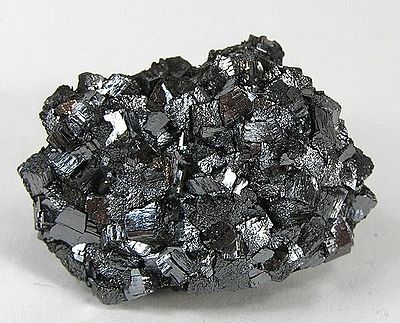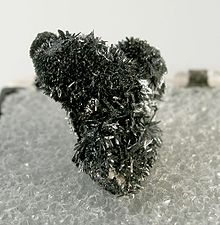Ramsdellite
| Ramsdellite | |
|---|---|
| Ramsdellite specimen from the Mistake Mine, Box Canyon District, Yavapai County , Arizona (size: 3.5 cm × 2.4 cm × 0.8 cm) | |
| General and classification | |
| other names | |
| chemical formula | γ-MnO 2 |
|
Mineral class (and possibly department) |
Oxides and hydroxides |
|
System no. to Strunz and to Dana |
4.DB.15a ( 8th edition : IV / D.10) 04.04.07.01 |
| Crystallographic Data | |
| Crystal system | orthorhombic |
| Crystal class ; symbol | orthorhombic-dipyramidal; 2 / m 2 / m 2 / m |
| Room group (no.) | Pbnm (No. 62) |
| Lattice parameters | a = 4.45 Å ; b = 9.32 Å; c = 2.85 Å |
| Formula units | Z = 4 |
| Physical Properties | |
| Mohs hardness | ≈ 3 |
| Density (g / cm 3 ) | measured: 4.65 to 4.83; calculated: 4.84 |
| Cleavage | good for three pinacoids and a prism |
| Break ; Tenacity | brittle |
| colour | steel gray to iron black; yellowish white in reflected light |
| Line color | black with a tinge of brown |
| transparency | opaque (opaque) |
| shine | strong metallic luster |
Ramsdellite is a rarely occurring mineral from the mineral class of "oxides and hydroxides". It crystallizes in the orthorhombic crystal system with the chemical composition MnO 2 , so from a chemical point of view it is a manganese (IV) oxide and, together with other manganese oxides, belongs to the group of brown stones .
Ramsdellite is opaque and is usually found in the form of leafy crystals or pseudomorphs according to groutite , but also forms fibrous or massive mineral aggregates of steel-gray to iron-black color and a strong metallic sheen . In the reflected light microscope , however, it appears yellowish white. However, his line color is always black with a tinge of brown.
With a Mohs hardness of 3, ramsdellite, like the reference mineral calcite, is one of the medium-hard minerals that can be scratched with a copper coin.
Etymology and history
The mineral was first discovered in Lake Valley County in the Sierra County of the US state of New Mexico and described in 1932 by Lewis Steven Ramsdell (1895-1975), who described it incompletely and without choosing a name for it.
Michael Fleischer and Wallace E. Richmond described the mineral again in full in 1943 and named it Ramsdellite after the person who first described it.
Type material of the mineral is stored in the University of Michigan (USA).
classification
Already in the outdated, but partly still in use 8th edition of the mineral classification according to Strunz , the ramsdellite belonged to the mineral class of "oxides and hydroxides" and there to the department of "oxides with the molar ratio metal: oxygen = 1: 2 (MO 2 and related compounds ) ", Where together with Nsutit he created the" Ramsdellit-Nsutit-Gruppe "with the system no. IV / D.10 and the other members Akhtenskit and Vernadit .
The 9th edition of Strunz's mineral systematics , which has been in force since 2001 and is used by the International Mineralogical Association (IMA), also classifies the Ramsdellite in the category of "Oxides with the molar ratio of metal: oxygen = 1: 2 and comparable". However, this is further subdivided according to the relative size of the cations involved and the crystal structure, so that the mineral is classified in the sub-section “With medium-sized cations; Chains edge-linked octahedra "can be found where the" Ramsdellitgruppe "is the only namesake with the system no. 4.DB.15a and the other member Paramontroseit .
The systematics of minerals according to Dana , which is mainly used in the English-speaking world , assigns the Ramsdellite to the class of "oxides and hydroxides" and there in the "oxides" category. Here he is to be found as the only member of the unnamed group 04.04.07 within the sub-section “Simple oxides with a cation charge of 4+ (AO 2 )”.
Modifications and varieties
The compound MnO 2 is trimorphic and crystallizes in addition to the orthorhombic ramsdellite as a tetragonal pyrolusite and as a hexagonal Akhtenskit .
Education and Locations
Ramsdellite is formed as a secondary mineral in manganese deposits , either by inversion from pyrolusite or by oxidative dehydration from groutite (MnO (OH)). The accompanying minerals include coronadite , hollandite , cryptomelane and pyrolusite.
As a rare mineral formation, Ramsdellite could only be detected at a few sites, whereby so far (as of 2014) around 80 sites are known. In addition to its Lake Valley type locality , the mineral occurred in the US state of New Mexico at Cuchillo Negro in Sierra County and in the Luis Lopez manganese mining area in Socorro County . In addition, it was found in the United States in many places in Arizona , in the California Chocolate Mountains , in Saguache County of Colorado and at Philipsburg ( Granite County ) and Butte in Montana.
In Germany, Ramsdellite has so far only been found in the Silberbrünnle mine in Haigerach Valley near Gengenbach , the Clara mine near Oberwolfach and in the Hartmann quarry near Mauer near Heidelberg in Baden-Württemberg; in the quarry on Glasberg near Nieder-Beerbach and in the Georg mine near Bockenrod (Reichelsheim) in Hesse; in the Winterberg quarry near Bad Grund (Harz) and in the Emilie mine near Peine in Lower Saxony as well as near Oehrenstock , Ilfeld and in the Henneberg quarry near Weitisberga in Thuringia.
The only known site in Switzerland so far is the Pipji glacier near Pipjitälli and Sparrenflue in the Täschtal in the canton of Valais.
Other locations are in Australia, Azerbaijan, Bulgaria, Burkina Faso, Chile, France, Ghana, Greece, India, Italy, Japan, Canada, Mexico, Norway, Portugal, Romania, Sweden, South Africa, the Czech Republic, Hungary and the United Kingdom (Wales).
Crystal structure
Ramsdellite crystallizes orthorhombically in the space group Pbnm (space group no. 62) with the lattice parameters a = 4.45 Å ; b = 9.32 Å and c = 2.85 Å as well as four formula units per unit cell .
For a description of the crystal structure, see brownstone (mineral group) # R-MnO2 (ramsdellite) .
Precautions
Similar to pyrolusite and psilomelan , ramsdellite is also considered harmful to health. When absorbed into the body ( incorporation , ingestion ) it causes gastrointestinal complaints and nausea.
The mineral itself does not burn, but decomposes when heated to over 535 ° C and increases the risk of fire if it comes into contact with flammable substances. It can also significantly promote an existing fire.
See also
literature
- Lewis Steven Ramsdell: An X-ray study of psilomelane and wad. In: American Mineralogist. Volume 17, 1932, pp. 143-149 ( rruff.info PDF; 1.89 MB).
- Michael Fleischer, Wallace E. Richmond: The manganese oxide minerals: a preliminary report. In: Economic Geology. Volume 38, 1943, pp. 269-286 ( rruff.info PDF; 908.8 kB).
- Michael Fleischer, Wallace E. Richmond, Howard T. Evans, Jr .: Studies of the manganese oxides. V. Ramsdellite, MnO 2 , an orthorhombic dimorph of pyrolusite. In: American Mineralogist. Volume 47, 1962, pp. 47-58 ( rruff.info PDF; 769.3 kB).
- Friedrich Klockmann : Klockmann's textbook of mineralogy . Ed .: Paul Ramdohr , Hugo Strunz . 16th edition. Enke, Stuttgart 1978, ISBN 3-432-82986-8 , pp. 537 (first edition: 1891).
- Helmut Schrätze, Karl-Ludwig Weiner: Mineralogy. A textbook on a systematic basis . de Gruyter, Berlin / New York 1981, ISBN 3-11-006823-0 , p. 449 .
Web links
- Mineral Atlas: Ramsdellite (Wiki)
- Mindat - Ramsdellite.
- Webmineral - Ramsdellite.
- Database-of-Raman-spectroscopy - Ramsdellite.
- American-Mineralogist-Crystal-Structure-Database - Ramsdellite.
Individual evidence
- ↑ a b c d Hugo Strunz , Ernest H. Nickel: Strunz Mineralogical Tables . 9th edition. E. Schweizerbart'sche Verlagbuchhandlung (Nägele and Obermiller), Stuttgart 2001, ISBN 3-510-65188-X , p. 208 .
- ↑ a b c Ramsdellite. In: John W. Anthony, Richard A. Bideaux, Kenneth W. Bladh, Monte C. Nichols (Eds.): Handbook of Mineralogy, Mineralogical Society of America. 2001 ( handbookofmineralogy.org PDF; 69.7 kB).
- ^ IMA / CNMNC List of Mineral Names; March 2014 (PDF; 1.5 MB).
- ↑ Mindat - Number of localities for Ramsdellit.
- ↑ Find location list for Ramsdellite at the Mineralienatlas and at Mindat .
- ↑ Entry for CAS no. 1313-13-9 in the GESTIS substance database of the IFA , accessed on April 8, 2008 (JavaScript required)


